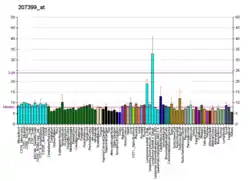| BFSP2 | |||||||||||||||||||||||||||||||||||||||||||||||||||
|---|---|---|---|---|---|---|---|---|---|---|---|---|---|---|---|---|---|---|---|---|---|---|---|---|---|---|---|---|---|---|---|---|---|---|---|---|---|---|---|---|---|---|---|---|---|---|---|---|---|---|---|
| Identifiers | |||||||||||||||||||||||||||||||||||||||||||||||||||
| Aliases | BFSP2, CP47, CP49, CTRCT12, LIFL-L, PHAKOSIN, beaded filament structural protein 2 | ||||||||||||||||||||||||||||||||||||||||||||||||||
| External IDs | OMIM: 603212 MGI: 1333828 HomoloGene: 20791 GeneCards: BFSP2 | ||||||||||||||||||||||||||||||||||||||||||||||||||
| |||||||||||||||||||||||||||||||||||||||||||||||||||
| |||||||||||||||||||||||||||||||||||||||||||||||||||
| |||||||||||||||||||||||||||||||||||||||||||||||||||
| |||||||||||||||||||||||||||||||||||||||||||||||||||
| |||||||||||||||||||||||||||||||||||||||||||||||||||
| Wikidata | |||||||||||||||||||||||||||||||||||||||||||||||||||
| |||||||||||||||||||||||||||||||||||||||||||||||||||
BFSP2 is a gene that encodes the protein phakinin ("beaded filament structural protein 2") in humans.[5]
More than 99% of the vertebrate ocular lens consists of terminally differentiated lens fiber cells. Two lens-specific intermediate filament proteins, the protein product of this gene (CP49 or phakinin) and filensin (also known as CP115), are expressed only after fiber cell differentiation has begun. Both proteins are found in a structurally unique cytoskeletal element that is referred to as the beaded filament (BF). Mutations in this gene have been associated with juvenile-onset, progressive cataracts and Dowling-Meara epidermolysis bullosa simplex.[5]
The two BFSP proteins are put into a "type VI" of intermediate filament (IF) classification. Unlike other IFs that form unbranched links, the two proteins form a network of filaments together with CRYAA.[6][7]
References
- 1 2 3 GRCh38: Ensembl release 89: ENSG00000170819 - Ensembl, May 2017
- 1 2 3 GRCm38: Ensembl release 89: ENSMUSG00000032556 - Ensembl, May 2017
- ↑ "Human PubMed Reference:". National Center for Biotechnology Information, U.S. National Library of Medicine.
- ↑ "Mouse PubMed Reference:". National Center for Biotechnology Information, U.S. National Library of Medicine.
- 1 2 "Entrez Gene: BFSP2 beaded filament structural protein 2, phakinin".
- ↑ Chaves JM, Gupta R, Srivastava K, Srivastava O (December 2017). "Human alpha A-crystallin missing N-terminal domain poorly complexes with filensin and phakinin". Biochemical and Biophysical Research Communications. 494 (1–2): 402–408. doi:10.1016/j.bbrc.2017.09.088. PMID 28935373.
- ↑ Szeverenyi I, Cassidy AJ, Chung CW, Lee BT, Common JE, Ogg SC, Chen H, Sim SY, Goh WL, Ng KW, Simpson JA, Chee LL, Eng GH, Li B, Lunny DP, Chuon D, Venkatesh A, Khoo KH, McLean WH, Lim YP, Lane EB. "Human Intermediate Filament Database". Szeverenyi I, Cassidy AJ, Chung CW, Lee BT, Common JE, Ogg SC, et al. (March 2008). "The Human Intermediate Filament Database: comprehensive information on a gene family involved in many human diseases". Human Mutation. 29 (3): 351–360. doi:10.1002/humu.20652. PMID 18033728. S2CID 20760837.
External links
- Human BFSP2 genome location and BFSP2 gene details page in the UCSC Genome Browser.
Further reading
- Merdes A, Gounari F, Georgatos SD (December 1993). "The 47-kD lens-specific protein phakinin is a tailless intermediate filament protein and an assembly partner of filensin". The Journal of Cell Biology. 123 (6 Pt 1): 1507–1516. doi:10.1083/jcb.123.6.1507. PMC 2290875. PMID 7504675.
- Hess JF, Casselman JT, FitzGerald PG (January 1995). "Chromosomal locations of the genes for the beaded filament proteins CP 115 and CP 47". Current Eye Research. 14 (1): 11–18. doi:10.3109/02713689508999909. PMID 7720401.
- Hess JF, Casselman JT, FitzGerald PG (March 1996). "Gene structure and cDNA sequence identify the beaded filament protein CP49 as a highly divergent type I intermediate filament protein". The Journal of Biological Chemistry. 271 (12): 6729–6735. doi:10.1074/jbc.271.41.25089. PMID 8636093.
- Bonaldo MF, Lennon G, Soares MB (September 1996). "Normalization and subtraction: two approaches to facilitate gene discovery". Genome Research. 6 (9): 791–806. doi:10.1101/gr.6.9.791. PMID 8889548.
- Hess JF, Casselman JT, Kong AP, FitzGerald PG (May 1998). "Primary sequence, secondary structure, gene structure, and assembly properties suggests that the lens-specific cytoskeletal protein filensin represents a novel class of intermediate filament protein". Experimental Eye Research. 66 (5): 625–644. doi:10.1006/exer.1998.0478. PMID 9628810.
- Conley YP, Erturk D, Keverline A, Mah TS, Keravala A, Barnes LR, et al. (April 2000). "A juvenile-onset, progressive cataract locus on chromosome 3q21-q22 is associated with a missense mutation in the beaded filament structural protein-2". American Journal of Human Genetics. 66 (4): 1426–1431. doi:10.1086/302871. PMC 1288209. PMID 10729115.
- Jakobs PM, Hess JF, FitzGerald PG, Kramer P, Weleber RG, Litt M (April 2000). "Autosomal-dominant congenital cataract associated with a deletion mutation in the human beaded filament protein gene BFSP2". American Journal of Human Genetics. 66 (4): 1432–1436. doi:10.1086/302872. PMC 1288210. PMID 10739768.
- Carter JM, McLean WH, West S, Quinlan RA (April 2000). "Mapping of the human CP49 gene and identification of an intragenic polymorphic marker to allow genetic linkage analysis in autosomal dominant congenital cataract". Biochemical and Biophysical Research Communications. 270 (2): 432–436. doi:10.1006/bbrc.2000.2442. PMID 10753642.
- Zhang Q, Guo X, Xiao X, Yi J, Jia X, Hejtmancik JF (November 2004). "Clinical description and genome wide linkage study of Y-sutural cataract and myopia in a Chinese family". Molecular Vision. 10: 890–900. PMID 15570218.
- Zhang L, Gao L, Li Z, Qin W, Gao W, Cui X, et al. (December 2006). "Progressive sutural cataract associated with a BFSP2 mutation in a Chinese family". Molecular Vision. 12: 1626–1631. PMID 17200662.
- Cui X, Gao L, Jin Y, Zhang Y, Bai J, Feng G, et al. (October 2007). "The E233del mutation in BFSP2 causes a progressive autosomal dominant congenital cataract in a Chinese family". Molecular Vision. 13: 2023–2029. PMID 17982427.




